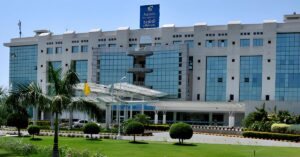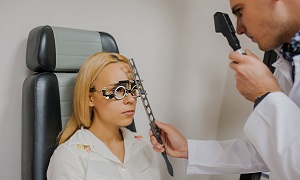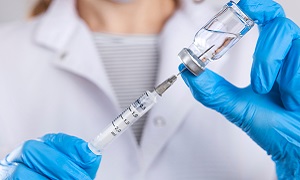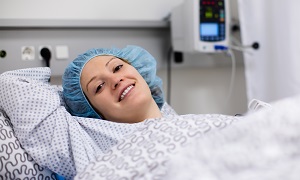Best Doctors in India for Blepharoplasty
Best Hospitals in India for Blepharoplasty
- City: Mumbai, India
Hospital Highlights:
- Fortis Hiranandani hospital was established in 2007.
- The hospital is an advanced tertiary care, multi-specialty hospital equipped with 149 beds.
- The hospital is equipped with a super ICU to provide emergency medical care to critically ill patients.
- The hospital is NABH accredited.
- The critical care facility in the hospital is augmented with the state-of-the-art facilities that facilitate speedier diagnosis and efficient monitoring.
- The hospital provides specialty medical services in cardiology, orthopedic science, pediatric science, neurology, diabetic care, urology, nephrology, ENT, obstetrics, gynecology, cosmetic surgery, bariatric surgery, neuro and spine care.
- City: Gurugram, India
Hospital Highlights:
- W Pratiksha Hospital, Gurugram, is one of the best hospitals in the NCR region. It is also a top hospital in India for IVF. Since its inception, the hospital has performed over 5500 successful IVFs. The hospital also specializes in gynecology.
- With over 20 years of experience in providing quality healthcare, the hospital is known as one of the most trusted and valued health providers in India.
- Equipped with world-class medical facilities and advanced technology, the hospital’s doctors and clinicians also have a track record of delivering excellent results. The hospital is also known for focusing on preventive well-being as much as on curative treatment.
- The hospital has earned the trust of its patients, by providing the best available treatments at affordable costs.
- City: Gurugram, India
Hospital Highlights:
- Paras hospital was established in 2006 and is the 250 bedded flagship hospital of Paras Healthcare.
- The is supported by a team of doctors of international and national repute.
- The hospital is NABH accredited and also the first hospital in the region to have a NABL accredited laboratory.
- The hospital provides specialty medical services in around 55 departments including Neurosciences, Joint Replacement, Mother & Child Care, Minimal Invasive Surgery, Gynecology and Obstetrics, Ophthalmology, Dermatology, Endocrinology, Rheumatology, Cosmetic and Plastic surgery.
- The hospital is equipped with state-of-the-art technologies.
- City: Kolkata, India
Hospital Highlights:
- Fortis Hospital, Anandapur, Kolkata is a world-class super-speciality equipped with the latest technologies in the medical world.
- The hospital is NABH accredited.
- This state-of-the-art facility specializes in cardiology and cardiac surgery, urology, nephrology, neurosciences, orthopaedics, digestive care, emergency care and critical care.
- The hospital, governed by integrated Building Management System (IBMS), has a pneumatic chute system, for quick vertical and horizontal transportation between floors, facilitating speedy transfer of patient specimens, documents, reports, and medicines to the concerned departments.
- The hospital also has a nephrology department with over 28 advanced dialysis units.
- City: Mumbai, India
Hospital Highlights:
- SL Raheja hospital is a 140-bed multi-specialty tertiary care hospital that is being managed by Fortis Healthcare Ltd.
- The hospital is a benchmark in healthcare and medical facilities in the neighborhood of Mahim & the western suburbs.
- L.Raheja Hospital, Mahim has one of the most effective ICU and Casualty care services.
- The hospital provides specialty medical services in Cardiology, Oncology, Neurology, Orthopedics, Mother & Child Care, and in Diabetes.
- City: Mumbai, India
Hospital Highlights:
- Wockhardt Hospitals were established in the year 1973, originally called First Hospitals and Heart Institute.
- Wockhardt Hospitals are super specialty health care networks in India, nurtured by Wockhardt Ltd, India’s 5th largest Pharmaceutical and Healthcare company.
- Wockhardt Hospitals is associated with Partners Harvard Medical International, an international arm of Harvard Medical School, USA.
- Wockhardt Heart Hospital performed India’s first endoscopic heart surgery.
- The hospital has a state-of-the-art infrastructure equipped with the latest technologies and modern equipment.
- It has special Centers of Excellence dedicated to the major specialties to provide hassle-free and high-quality clinical care.
- City: Gurugram, India
Hospital Highlights:
- The CK Birla Hospital in Gurugram is a NABH-accredited multi-specialty hospital.
- The hospital strives to increase the quality of healthcare by focusing on UK NHS nurse and midwife training requirements. Policies and practices derived from the National Institute for Health and Treatment Excellence (NICE) recommendations in the United Kingdom ensuring that a strong focus on safety, high-quality clinical care, and sanitation is maintained.
- The hospital’s cutting-edge technology and facilities allow for real-time communication and seamless collaboration among caregivers, ensuring accuracy and the best possible results. Those with foreign experience and accreditations make up part of the hospital’s team of clinicians.
- City: Ahmedabad
Hospital Highlights:
- As a member of the Apollo Hospitals Group, Apollo Hospitals International Limited, Ahmedabad is one of the most popular and sought-after medical facilities in Gujarat.
- Through its 6 Centres of Excellence and various affiliated branches, which cover all specialties and subspecialties, the hospital provides the most advanced clinical services.
- Since its inception in 2003, the hospital has been providing each patient with the most up-to-date medical equipment and state-of-the-art technology.
- With more than 150 successful organ transplants, including liver and renal transplants, the facility has been able to build a strong and extensive organ transplant program.
- In addition to performing 600 surgeries and caring for over 1800 patients on an IP basis, the hospital sees more than 18,000 patients on average in the outpatient department.
- With one of the biggest cardiology teams in the area, the hospital provides state-of-the-art regional care treatment in Cardiac Sciences.
- Additionally, the hospital offers a broad range of Neuro Interventional techniques to help stroke patients recover more quickly.
- City: Noida, India
Hospital Highlights:
- Jaypee Hospital is the flagship hospital of the Jaypee Group.
- This hospital has commissioned 525 beds in the first phase and has been planned and designed as a 1200 bedded multi-specialty facility.
- It holds the accreditation of the NABH and NABL.
- The hospital has state-of-the-art infrastructure equipped with the latest technologies and modern equipment like 64 Slice PET CT, Dual Head 6 Slice SPECT CT, Gamma Camera, and Da Vinci Robotic Surgery for comprehensive robotic surgical solutions.
- It has special Centers dedicated to the major specialties to provide hassle-free and high-quality clinical care.
- City: Mumbai, India
Hospital Highlights:
- Reliance Hospital is one of the best super-specialty care hospitals in Navi Mumbai.
- The main purpose of this hospital is to become a trustworthy place for the best health and hope for society. The hospital is well connected to the suburbs of Mumbai and Navi Mumbai.
- The hospital has various specialty departments, viz., Accident & Emergency, Anesthesiology, Dental Services, Dermatology, Diabetology, Dietetics Nutrition, Endocrinology, ENT, Gastroenterology, General Surgery, Gynaecology And Obstetrics, Hepato Pancreato Biliary Surgery, Infectious Disease, Internal Medicine, Interventional Radiology, Laboratory Medicine, Minimal Access Laparoscopic Surgery, Nephrology, Neurosciences, Opthalmology, Orthopaedics, Paediatrics, Pain Management Palliative Care, Physical Medicine Rehabilitation, Plastic And Reconstructive Surgery, Psychiatry, Pulmonary Medicine, Radiology, Rheumatology, Transplant, Urology Andrology, Vascular Surgery
BLEPHAROPLASTY
Blepharoplasty is a procedure for treating droopy eyelids. It is a type of plastic surgery, where your doctor removes skin, muscle and sometimes fat that may be causing sagging in the area around your eyes.
As we age, our eyelids stretch and the muscles supporting them also become weak. Due to this, excess fat can gather above or below the eyelids, which leads to sagging eyebrows, droopy upper lids as well as bags under the eyes.
Sagging skin around your eyes not only makes you look older but also reduces your peripheral vision. Blepharoplasty is a procedure that can eliminate these kinds of vision problems and they help in making your eyes appear younger and also more alert.
Purpose
This procedure is usually sought by people who are seeking anti-aging treatments. Though sagging of the skin around the eyes is a natural part of aging, some people might find this bothersome, which is why they might opt for this surgery. People who have significant bags under the eyes or people whose eyebrows start to sag might also consider Blepharoplasty.
Although many people prefer this surgery for cosmetic reasons, there are others who choose to go for the surgery if their vision is affected by the sagging skin. Some people can also find their vision blocked by the hanging skin when they look upward.
Preparation
- Your medical history: Your surgeon will ask about any previous surgeries as well as your past or current conditions, such as dry eyes, glaucoma, circulatory problems, allergies, thyroid problems and diabetes. If you are taking any kind of medications, herbal supplements, vitamins, alcohol, tobacco or drugs you need to inform your doctor.
- Your expectations: You will need to discuss your expectations honestly as it will help you with a satisfactory outcome. Your surgeon will also discuss how likely the procedure is to work well for you.
Before the surgery, you’ll need to undergo:
- A physical examination: A physical examination will be conducted by your surgeon. This might include testing your tear production and measuring parts of your eyelids as well.
- A vision examination: Your eye doctor will be examining your eyes and test your vision including your peripheral vision. This helps in supporting any insurance claim.
- Eyelid photography: Your eyes will be photographed from various angles. These photos will help in planning the surgery and to assess its immediate and long-term effects as well as supporting an insurance claim.
Your doctor will ask you to stop taking any medications before your surgery unless he/she approves them.
You will also need to quit smoking a few weeks before the surgery. Smoking affects your healing after surgery.
If you are having outpatient surgery, it is best if you are able to arrange someone to drive you to and from the surgery. You will need to plan to have someone stay with you the first night after you return home from the surgery.
Procedure
Blepharoplasty is usually done on an outpatient basis. Your surgeon will first inject a numbing medication into your eyelids and then administer intravenous medication to make you relax.
If the surgery is being performed on the upper and lower eyelids, the surgeon will generally work on your upper lids first. He/she can cut along the fold of the eyelid, remove some of the excess skin, muscle and possibly fat and then close the cut.
After this, your surgeon will perform on the lower lid. He/she will make a cut just below the lashes in your eye’s natural crease or inside the lower lid. He/she will remove or redistribute excess fat, muscle, sagging skin and then close the cut.
Recovery
Compared to other surgeries, recovery from Blepharoplasty usually takes a shorter time. After the procedure, you will be moved to a recovery room, where you’ll be monitored for side effects. You will be able to go home the same day unless there are any complications.
Following the surgery, it is best to take rest for a few days. You might also go through some pain. Your doctor can recommend a few medications to help you relieve any symptoms. It might take a week or two for these symptoms to disappear completely. For the next couple of days, your surgeon might recommend ice packs.
Sometimes, there might be short-term side effects such as blurry vision and sensitivity to light. If these symptoms last longer than two days, then you need to call your doctor.
Following the surgery, you will not be able to wear contact lenses, so make sure you have an alternative.
Although you won’t need to keep the eyes covered throughout the entire recovery phase, you might receive some gauge to help protect the area. Make sure that you wash the area gently and also keep it clean. After some days, you will need to see the surgeon again for an evaluation and remove any stitches as required.
Risks
The surgery carries the risk of bleeding, bruising and infection. Although rare, Blood clots can be a serious risk.
Other risks and complications include:
- blurry vision
- scars
- damage from excessive sun exposure
- itchiness around the eye area
- dry eyes
- muscle damage
- inability to close your eyes
It is best to discuss with your doctor about these risks before the procedure. Also inform your surgeon if you have had any complications before with any previous surgery in the past.














